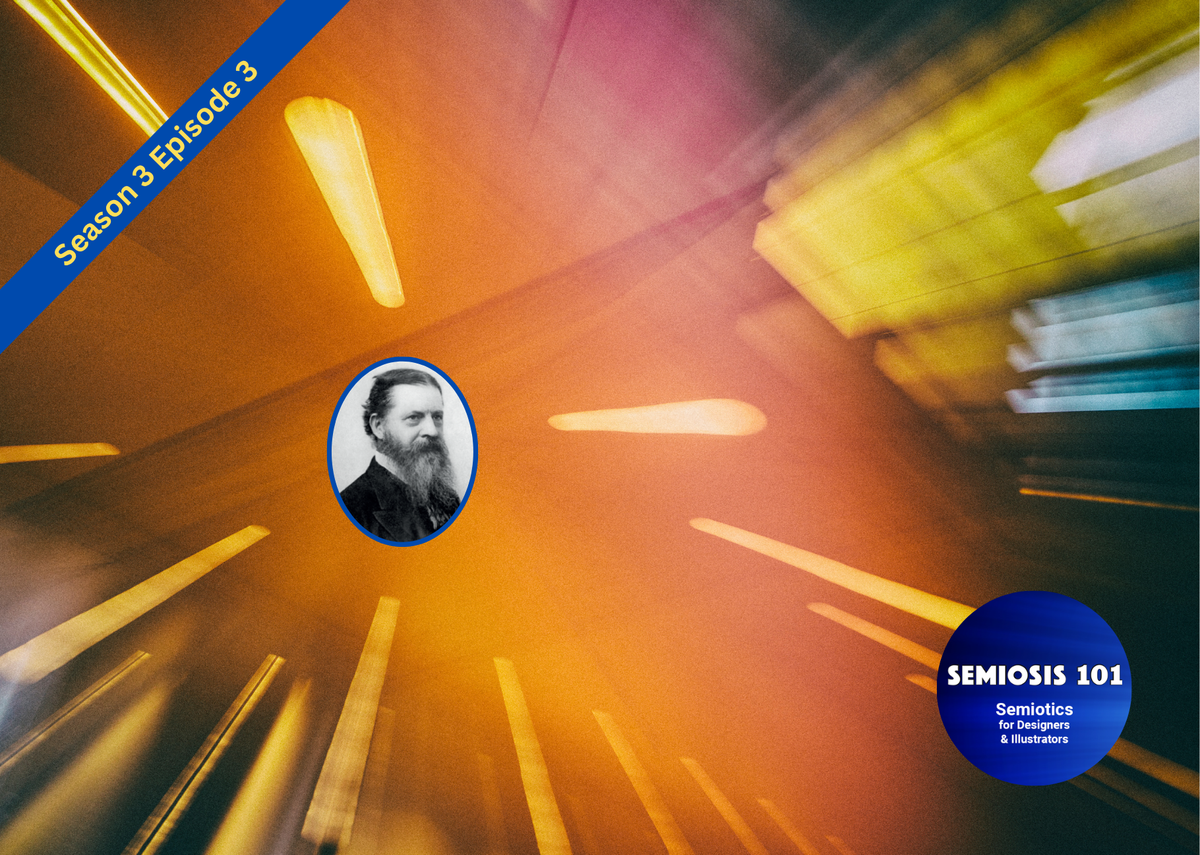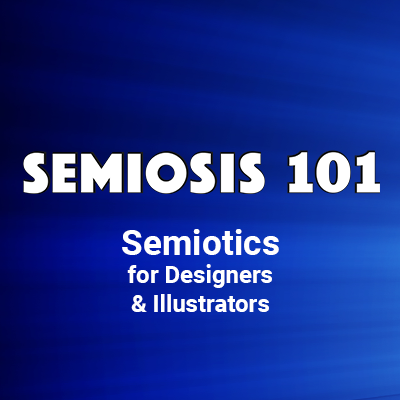Free Semiosis 101 Transcript 3.3:

DYNAMICALLY ADDING VISUAL MEANING: Semiotic Meaning-bearing 2
Hello readers.
In this free transcript for the episode published on Semiosis 101 on 1 Nov 2023, we discuss how once semiotic sign-action has perceptually been activated, the interpreter moves from an immediate state to a dymamic state of semiotically interpreting meaning. This has an effect on the interpreter.
Watch the free episode on YouTube for the full impact…
…and here is the episode’s transcript.
Last week we focused on the Peircean definition of the immediate effect in a state of Firstness a semiotic sign has on its interpretation. The immediate state is the lowest level of semiotic interpretation. Before the dynamic and final states can be arrived at, a semiotic sign has to be perceived as signifying something. Then an interpretation can be dynamically formed.
Hit subscribe to this YouTube channel, and I will explain…
Peirce calls this next state after the immediate state of the effect of the semiotic sign on the interpretation, the dynamic state. This is when interpretation moves from perceived meaning-bearing possibilities of a shape, to its pattern causing a mediated effect on the interpreter in some way affording an interpretation. This mediation effect is the semitic sign’s visual language helping the interpreter toward the desired interpretation. Let us return to our panda illustration example from last week’s episode.
The drawing of a panda is not a panda. A panda is an animal which eats bamboo, looks cute and is endangered in the wild. This is a drawing comprising of Iconic lines and shapes …black blobs and black marks that form a pattern. Last week we explored that the immediate effect on interpretation only took an interpreter so far. The immediate effect only took the interpretation from “black” to “blobs” and then to “pattern?” An act of perceiving possibilities of meaning, and whether there is intention behind the arrangement of black blobs, which could bear meaning.
If the designer or illustrator intends the blobs to form a thing, something other than its parts that means something, then you are encoding semiotic signs. You have always been doing this, even if you never realised it. That will be my point this season. You have been encoding semiotic signs, in your visual communication work, for as long as you have been creatives. Semiosis 101 just now names it and demonstrates how to control and apply the semiotic sign-action, to enhance YOUR visual communication skills.
So far, with the panda drawing, we have interpreted a pattern. Subconsciously, we are trying to perceive whether this pattern of black blobs and marks are of something? (Remember the blobs could be random, like an ink blot). What could this pattern be? It is not geometric so it is not just a pattern. It forms the shape of something.
At this moment, which has moved the interpreter from the phenomenological state of Firstness, a state of perceived possibilities to now a state of Secondness. The perception level where, in semiotically representing a concept, the visual language moves from Iconic representation to Indexical representation; from possibilities to existent things.
In interpreting the representation form the semiotic sign takes, the interpreter is now aware that there is something interpretable - there is meaning to be understood. In our example, if you have knowledge of animals then you can dynamically interpret meaning. By looking at the drawing and see that the pattern of arranged blobs and lines in black are not random, but form something, then that small interpreted step is a mediated event.
The semiotic signs …yes signs… nested together in a pattern, mediate a perception “event.” Before you are aware of an “animal” it was a pattern, and before being aware of a pattern there were just random “blobs.” In milliseconds, an interpreter’s perception and interpretation of what they are looking at, has moved from NO sign-action to semiotic sign-action.
The sign-action once perceptually activated, moves the interpreter from an immediate state to a dymamic state of semiotically interpreting meaning. What are essentially Iconic lines and shapes, now mediate the interpreter “THERE!” …in the direction of the desired intended meaning (concept).
Peirce describes this dynamic state (his Dynamic Interpretant), as the interpreter’s perceivable reaction to the encoded semiotic sign, based on what they individually feel and do when presented with the sign. The interpreter’s reaction is to understand the visual clues through their internal lenses of cultural knowledge and their individual lived experiences.
This is why the Danish semiotician Thorkild Thellefsen describes these states as corresponding to culture. He argues that understanding cannot disregard culture, as that is where we mediate our understanding of the world. We scan our own culturally-acquired knowledge to seek a proposition of what the meaning could be. Let us return to the panda.
Bear with me, in this demonstration we have not yet understood this drawing to be a “panda.” We are still at the moment of pattern interpretationv. Remember? In this example I am using I am taking my time explaining what for most interpreters has been a millisecond. (I bet 99.99999% of you immediately saw the panda, but bear with me …pun intended).
The pattern of Iconic shapes have formed a familiar pattern in your mind. You can interpret what looks like a head, a body and legs. The dynamic state that the mediation of these elements now presents the interpreter, is one of proposing an “animal” shape.
Is it a bird?
No.
Is it a reptile?
No.
Is it a mammal?
Yes.
Is it a small mammal like a rodent?
Probably not.
Is it bigger, like a dog.
Yes, but probably bigger.
But it is just a drawing.
So far so good?
These “blobs” are all meaning-bearing. But they are just …blobs? The mediated form that the individual simple Iconic representations take, which are arranged in a particular pattern, are meaning-bearing. Each individual semiotic sign individually offers the viewer the opportunity to interpret a body part. Collectively the signs when formed into a pattern now can indicate form, bulk, weight and even size. But they are only black blobs and lines. They are also clever semiotically encoded signs.
Blobs or semiotic signs? Can they be both? Sure. Remember its power is in the hands of two people. The creative and the interpreter. Is it a blob or an elegantly crafted meaning-bearing visual element? The creative is responsible for the intent behind the mark. Is it an ear, a leg, an eye …or a blob? The target audience will interpret which one.
How does the creative - YOU - ensure the dynamic effect? Whatever we as creatives design or illustrate is mediation. We bring into being visuals that have meaning. We also bring these visuals into being with meanings we do not intend if we are not careful. Semiosis 101 is focused on mindful designing and illustrating, through applying Semiosis to ensure clarity of meaning. This means mindful consideration of the effect of the visual, on the interpretations the target audience could take from what is mediated. This means considering the fact that just because, as a creative, you know what a panda is, everybody also knows. What if your target audience have never seen or experienced a panda? (An extreme example I know, but valid if you take the general intent of making assumptions on your audience’s knowledge without first researching).
Back to the large mammal. Just as the immediate state is a possibility of this visual quality representing this thing (a Rheme), then the dynamic state is one in which the possibility becomes a proposal that THIS thing is THAT thing. Peirce calls this a Dicent, an intermediate subclass of interpretation between the immediate and final effect on the interpretation. A visual proposal that mediates the interpreter to perceive that THIS thing they now see, is THAT thing they know.
In the panda drawing we are at the “mammal” stage of interpretation. A proposal that these shapes ARE an animal. A large animal. The qualities in the drawing that suggest form, bulk, weight and size, suggest a “bear” shape - if the interpreter knows what bears look like. Remember what I said earlier about creative’s making assumptions without researching?
We are now, in this panda drawing example, at the safe dynamic state of interpretation to interpret the form, bulk, weight and size of the bear drawing’s Iconic representations is a panda. Why can we be sure, as interpreters, this is not a Grizzly bear? The distinctive black and white patterns of existent panda bears are culturally well known. So the mediation in the drawing of balancing the black and white Iconic shapes in a particular pattern, reinforces the interpretation that Indexically this drawing represents a panda.
But remember about mediation? Remember when I said earlier about the effect of interpretation? The drawing could lie. The panda markings could be on a Grizzly bear shape. Come back next week to explore how to ensure the final state of Interpretation is what is encoded.
Semiosis 101 Semiotic Design Resources is a reader-supported publication. To receive exclusive posts and support my work, consider becoming a free or paid subscriber. Paid subscribers get name checked on all future Semiosis 101 YouTube episodes.
===Semiosis 101 Patreon Producer==============
Become a Semiosis 101 Patreon Producer and get a named producer credit on future video episodes, plus watch all new episodes months ahead of YouTube.
===Semiosis 101 Patreon Exclusives==============
Watch longer Patreon-exclusive Semiosis 101 episodes on applying Semiosis into design and illustration…
PATEXC001 How does semiotics work in illustration?





